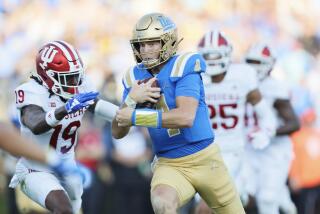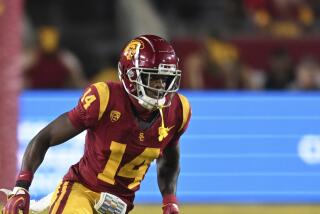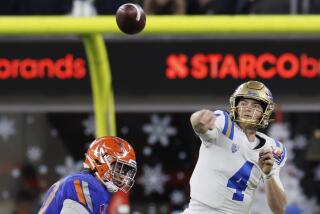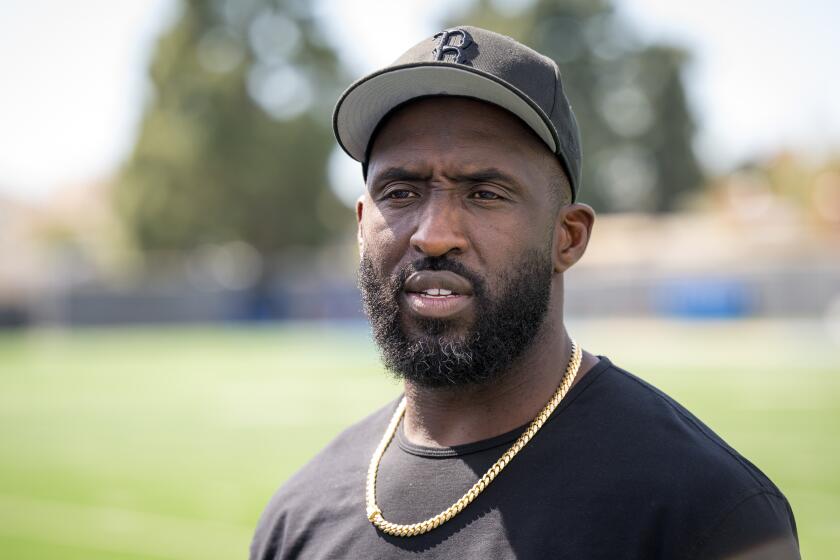Handle With Care
- Share via
Catastrophic events such as the death of football players do more than offer guideposts for the future.
New light is cast on the past.
Remember the UCLA opener, Aug. 30, 1997, when freshman Jermaine Lewis was stopped on fourth down from the one in the waning seconds and Washington State held on, 37-34?
Standing on the sideline was Skip Hicks, who had rushed for 190 yards that day. Why, oh why, didn’t Coach Bob Toledo put him in to carry the ball, the Bruin faithful cried.
Rather than stupid, maybe the decision was sensible.
Rather than knuckle-headed, maybe it was level-headed.
Maybe Hicks was too exhausted to walk straight, too delirious to think straight, and the coach, coming off a 5-6 rookie season and in dire need of a victory, acted responsibly, trading a game for a life.
Hicks, who had broken off a 92-yard run in the first quarter and accumulated 27 carries on an unseasonably hot day in Pullman, Wash., took himself out of the game two plays earlier after almost collapsing on the field.
“I can’t go anymore, Coach,” Hicks told Toledo.
Toledo took him at his word and the Bruins paid the consequences. But only for a moment.
Hicks, a Chicago Bear running back and veteran of three NFL seasons, survived. So did Toledo, who will begin his sixth season at UCLA.
“I’d handle it exactly the same way,” Toledo said. “He had all the symptoms of heatstroke. When a kid tells me he can’t go anymore, I don’t play him anymore.”
As a nation grieves over the deaths of Minnesota Viking lineman Korey Stringer and Northwestern defensive back Rashidi Wheeler, training camp will begin Saturday for UCLA, USC and numerous other college teams.
Everyone wants to be assured another tragedy won’t occur. But a delicate balance must be struck by young men schooled in machismo and steeped in toughness: They need to be in top condition to withstand rigorous games, yet getting into top condition can be dangerous.
Pete Carroll, beginning his first season as USC coach after many years in the NFL, plans to educate his players about the warning signs of dehydration.
“We’ll do the normal precautions, but we’ll also let them know so they can help us,” he said. “We want to make it clear to them this is not about toughness, it’s about taking care of themselves.”
Beyond this admonition, no changes are in store. NFL camps last six weeks and Carroll believes he needs every minute of the shorter camp the NCAA allows.
“Our camp is going to be real tough,” Carroll said. “They’re all young players and you can’t assume they get it. They don’t have [preseason] games to prove themselves. So practices will be physical.
“I’ve done this before. I’m not concerned about having to change things drastically. We just have to be smart. If we need breaks, we’ll take breaks.”
USC will train on campus after having held camp at cooler UC Irvine for several years. Moving camp 50 miles away poses logistical problems Carroll did not want to bother with in his first season. John Robinson made the same decision in 1994, then Paul Hackett moved the Trojans back to Irvine in 1998.
Temperatures at UCLA rarely exceed 85 degrees. Geoff Schaadt, director of training and rehabilitation, is one of three certified athletic trainers who attend practices along with 12 student trainers, following players and monitoring their hydration.
“Players have water and Gatorade available everywhere they go, in the locker room, dorms, meeting rooms and practice field,” Schaadt said. “There is no excuse for them not to have a drink in their hand. The coaching staff never restricts their ability to drink during practice.”
Trainers know which players are asthmatic or have other medical problems. USC sophomore Nathan Goodson suffered an asthma attack at practice last season. Trainers called an ambulance, he was taken to California Hospital for a precautionary examination and returned to campus 20 minutes later.
USC has six asthmatics on its roster and the training staff plans to keep oxygen tanks on the field during practice. Previously the tanks were kept at Heritage Hall, about 100 yards from the field.
“We learned something there,” said Russ Romano, USC head athletic trainer. “We hook them up, let them breathe that pure oxygen and their breathing calms down.”
Neither UCLA nor USC conduct a conditioning drill as strenuous as the one that preceded Wheeler’s death at Northwestern. The Bruins did their toughest conditioning this week under the supervision of strength and conditioning coach Mike Linn, three sets of six 50-yard sprints in a prescribed time with a 3-minute 30-second rest between each set.
“It’s a total of 900 yards with generous rest,” Linn said. “Trainers assess the athletes during the rest periods. Of course the players can drink water. We go the extra mile in terms of hydration, getting kids to buy into the whole idea.”
Showing up at camp in top shape is the key. Most UCLA and USC players spent the summer on campus, running and lifting weights in unofficial workout sessions.
“We do [Linn’s conditioning drill] as a gauge,” Toledo said. “If they pass it, we won’t do any conditioning during morning practices. If a bunch of guys fail it, we’ll do more conditioning during practice.”
Training camp begins with three days of practices in shorts. “Then,” Carroll said, “we crank it up.”
That means two practices a day, along with physical conditioning, walk-throughs and meetings. The first Trojan scrimmage is scheduled Aug. 18 and the first game is Sept. 1 against San Jose State at the Coliseum.
UCLA will open against Alabama at Tuscaloosa, where stifling heat and humidity are expected. Conditions could be similar for the second game, against Kansas at Lawrence.
“We stress hydration regardless of where and when a game is simply because we want it to become habit for the athletes,” Schaadt said. “We’ll go so far as set up ice buckets and towels for a November game in the Northwest. It’s not inconceivable a guy could overheat.”
Because of television, games begin earlier in the year than ever, earlier in the day than ever and often last well over three hours. The college game has become an endurance test.
“Games are tougher than practice,” Schaadt said. “The Rose Bowl is a lot hotter than Westwood. You take guys weighing 300 pounds and make them sweat for four hours. Even though there is time between plays, they don’t stop sweating. It’s no wonder guys develop cramps in the fourth quarter.”
Most players are reluctant to beg out of a practice drill or game situation because of exhaustion.
“To a point, guys want to show they are tough,” said DeShaun Foster, UCLA senior running back. “But you’ve got to know your body and keep the fluid coming.”
Hicks was quick to second-guess telling Toledo how tired he was that day four years ago. But he was more disappointed in his condition, suggesting he did not work hard enough during training camp.
“I mean, one yard, just hold your breath and run,” he said. “I’m so upset at myself for that. I was drained. I should have been in better shape.”
Train hard, but train smart. The deaths of Stringer and Wheeler are shocking reminders for players to know their limits.
“I don’t think it makes any of us worry so much as we are aware of it,” said Alex Holmes, a Trojan tight end. “Everyone knows what’s going on.”
More to Read
Go beyond the scoreboard
Get the latest on L.A.'s teams in the daily Sports Report newsletter.
You may occasionally receive promotional content from the Los Angeles Times.








